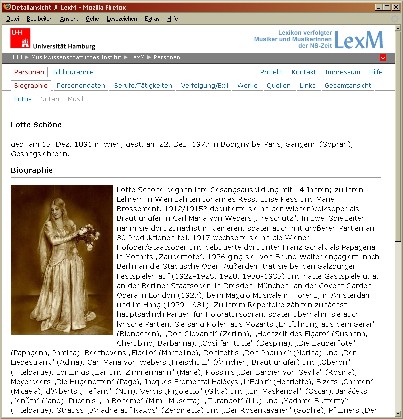Biographical Dictionary of Persecuted Musicians 1933-1945
screenshot: LexM
edited since 2005 at the University of Hamburg
by: Claudia Maurer Zenck and Peter Petersen
editorial assistant: Sophie Fetthauer
| home page: | http://www.lexm.uni-hamburg.de |
|---|---|
| contact: | sophie.fetthauer@uni-hamburg.de |
The Biographical Dictionary of Persecuted Musicians 1933-1945 focusses on musicians who were persecuted in Germany between 1933 and 1945 for racial, political, cultural, religious, ideological or other reasons. Theses lives, that were deeply affected by discrimination, deprivation, imprisonment in ghettos and concentration camps, concealment or exile will form the centre of the project. It will include professional musicians of all ages who were persecuted by the NS-state and who lived, worked or were known in Germany or Austria. Every field of musical activity will be included: composition, interpretation, education, scholarship and music management. Our aim is to provide a completely new foundation to all research concerned with the destructive effects of musicians' persecution and expulsion as well as the constructive effect of migration for the global music culture. This should give a better understanding of 20th century’s music history and of musical life today and, in addition, should have the benefit to rediscover musicians who have been completely forgotten. Thus, the project has two aims: On the one hand we want to inform about every single fate, on the other hand we want to provide an instrument for further research on persecution and exile of musicians.
The biographical dictionary contains two types of records: 1. records concerning musicians (“Personen”), 2. records concerning literature and sources (“Bibliographie”). The individual entries concerning musicians will provide a biography, describe his or her professional and other activities with particular reference to the history of persecution and exile. A list of works, documents and literature and photos will be added to every article. One has to distinguish between two types of records: freely formulated text on the one hand and lists of keywords that are formulated in advance on the other hand. At the moment 2.700 personal records of musicians can be found in the biographical dictionary - about 400 detailed articles and about 2.300 short articles (December 17, 2009). In future we intend about 5.000 records of musicians will be published. The bibliography contains records of literature (books, essays, newspaper-articles etc.) as well as documents from archives. At the moment about 8.400 records are accessible (December 17, 2009).
The Biographical Dictionary of Persecuted Musicians 1933-1945 uses the content management system ‘MyCoRe’ (version 2.0) in connection with the database ‘Exist’ in a scholarly context. Academic texts about musicians are presented systematically. They include the possibility of placing references (links to literature and sources as well as to articles about other musicians) and using detailed search functions.
The articles about musicians are written by the editors and student assistants as well as external scholars. Editorial work is done by the editors and the collaborator. Corrections of the articles and submission of articles into the biographical dictionary are realised by the collaborator. The biographical dictionary is a source of information for the scholarly public, namely universities, conservatories, research establishments, opera houses, concert artists' agencies, publishers and record industry, as well as the public at large.